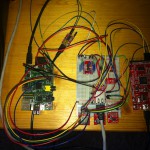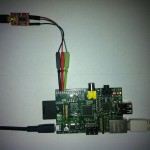I was lucky enough to finally receive my Raspberry Pi last Friday. I ordered it from Farnell as early as I possibly could, and my order was dated 08:34:24 29/02/2012. Of course I’ve been playing with it since, and have mostly been working on the kernel – getting things cleaned up a bit and upgraded a bit. So the first thing to announce is I’ve got a little stash of Raspberry Pi-related stuff available for people to try.
Linux 3.2.16 kernel
The main improvement is that you can boot the compressed kernel and that early printk works. Using either of these caused the RPi to hang at boot due to the early console code being badly broken, but my changes (available on GitHub) initialise the serial port (115200 Kbps 8n1) if you boot the compressed image and give you serial output as soon as possible. This is very useful for debugging the kernel.
I’ve also rebased the 3.1.9-based official tree against 3.2.16 to bring it more into line with what Debian Wheezy expects at the moment. Simon has his own tree where we’re working on 3.3 and more recent kernels, ideally aiming for mainline inclusion at some point in the future. This is a big job though.
So without further ado, grab yourself the pre-built 3.2.16 kernel and install it like this (as root):
dpkg -i linux-image-3.2.16-rpi1+_1_armel.deb- Backup your
/boot/kernel.img.
cat first32k.bin /boot/vmlinuz-3.2.16-rpi1+ > /boot/kernel.img- Reboot
Please let me know if you have any issues with this kernel (that you don’t also have with the stock kernel)!
Minimal Debian Wheezy disk image
In my travels with the Raspberry Pi I found that the official Debian image wasn’t to my liking. Not only does it have lots of unnecessary (for me) software installed, but certain configuration files are badly mangled (such as /etc/passwd and family). The image is also based on Squeeze, though I admit it’s easy enough to dist-upgrade to Wheezy. Regardless, I decided to start from scratch using debootstrap (and working around some interesting issues) I built a minimal Debian Wheezy image.
This has the bare minimum changes from a plain debootstrapped system to get a working Raspberry Pi. It runs DHCP on eth0 at boot and runs ntpd, but does not have openssh-server installed. It starts consoles on both the serial port (115200 8n1) and the HDMI display. The time zone is set to UTC. The kernel, of course, is my 3.2.16 kernel from above.
Update 2012-05-11: I have updated my image to fix the udev problem mentioned below. Please see my latest post about it.
Download wheezy-mini-2012-05-08.img.gz (113M). The root password is raspberrypi.
Please note: There is one known issue with the above image which means that your eth0 will be renamed to eth1 and networking will not be brought up automatically. This is easy to fix: just edit /etc/udev/rules.d/70-persistent-net.rules and remove the two sets of rules with their comments at the end of the file, then reboot. I have created an updated image that fixes this problem.


